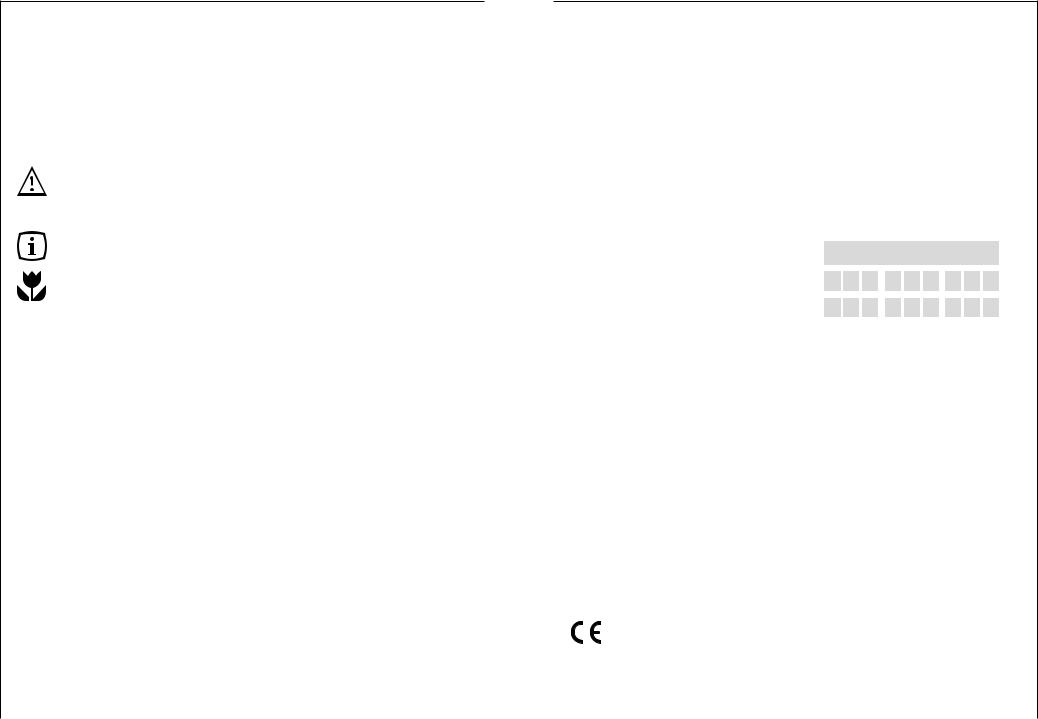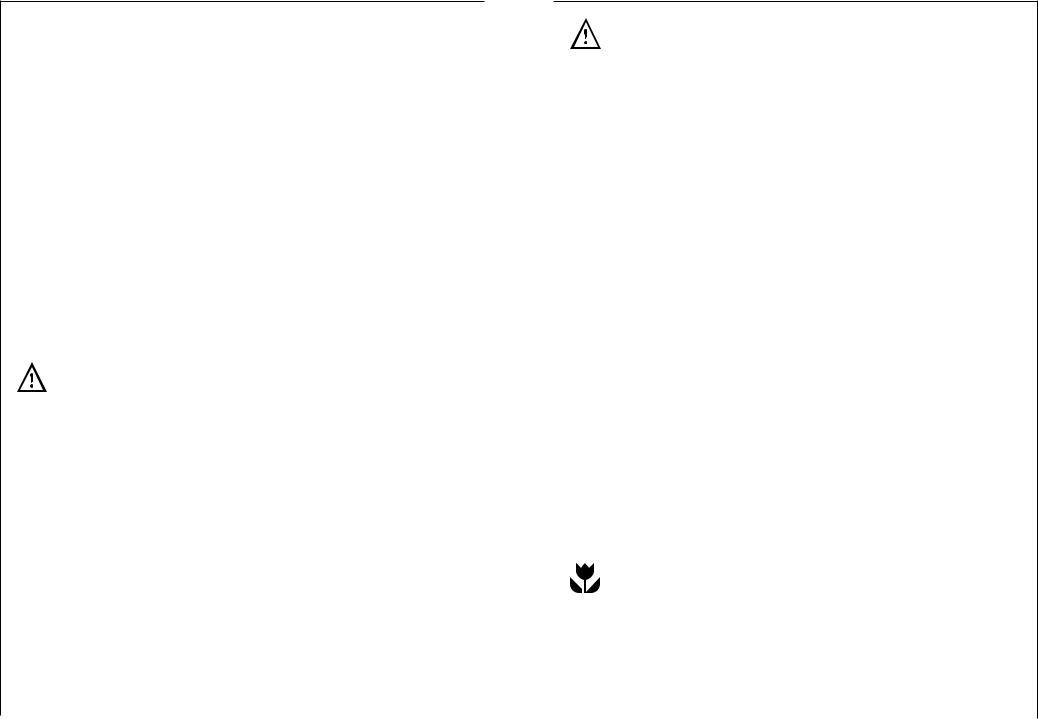AEG-Electrolux ARCTIS150-4GS User Manual
ARCTIS 150-4 GS
Gefrierschrank
Freezer
Gebrauchsanweisung
Operating Instructions
AEG Hausgeräte GmbH
Postfach 1036
D-90327 Nürnberg
http://www.aeg.hausgeraete.de
2222 061-53

Sehr geehrte Kundin, sehr geehrter Kunde,
bevor Sie Ihr neues Kältegerät in Betrieb nehmen, lesen Sie bitte diese Gebrauchsanweisung aufmerksam durch. Sie enthält wichtige Informationen zum sicheren Gebrauch, zum Aufstellen und zur Pflege des Gerätes.
Bewahren Sie bitte die Gebrauchsanweisung zum späteren Nachschlagen auf. Geben Sie sie an eventuelle Nachbesitzer des Gerätes weiter.
Mit dem Warndreieck und/oder durch Signalwörter (Warnung!, Vorsicht!, Achtung!) sind Hinweise hervorgehoben, die für Ihre Sicherheit oder für die Funktionsfähigkeit des Gerätes wichtig sind. Bitte unbedingt beachten.
Nach diesem Zeichen erhalten Sie ergänzende Informationen zur Bedienung und praktischen Anwendung des Gerätes.
Mit der Blume sind Tips und Hinweise zum wirtschaftlichen und umweltschonenden Einsatz des Gerätes gekennzeichnet.
Für evtl. auftretende Störungen enthält die Gebrauchsanweisung Hinweise zur selbständigen Behebung, siehe Abschnitt "Was tun, wenn ...". Sollten diese Hinweise nicht ausreichen, steht Ihnen unser Kundendienst jederzeit zur Verfügung.
Gedruckt auf umweltschonend hergestelltem Papier
– wer ökologisch denkt, handelt auch so ...
Customer Service
If you cannot find the remedy for a malfunction in these operating instructions, please contact your dealer or our customer service department. Addresses and telephone numbers are listed in the accompanying booklet "Guarantee Conditions/Customer Service Locations".
Selective ordering of replacement parts can save unnecessary travel and costs. For this reason always provide the following appliance information:
This information can be found on the serial plate in the interior at the left of the appliance.
• Model Name
• Model Number (PNC)
• Serial Number (S-No.)
We recommend that you enter this information here, so that it is handy if needed.
Note: The customer bears the costs of unjustified customer service calls even during the guarantee period.
Regulations, Standards, Guidelines
This appliance was designed for household use and was manufactured in accordance with the appropriate standards. The necessary measures in accordance with appliance safety legislation regulations (GSG), accident prevention regulations for refrigeration appliances (VBG 20) and the regulations of the German Society of Electrical Engineers (VDE) were observed in the manufacture of this appliance.
The refrigerant circuit has been checked for leaks.
This appliance is in accordance with the following EU guidelines:
– 73/23/EWG dated 19 February 1973 - low voltage guidelines.
– 89/336/EWG dated 3 May 1989
(including guideline change notice 92/31/EWG) - EMV guideline
2 |
39 |

Malfunction |
Possible Cause |
Remedy |
|
|
|
Unusual noises. |
Appliance is not level. |
Readjust the feet. |
|
The appliance is touching |
Move the appliance slightly. |
|
the wall or other objects. |
|
|
A component, e.g. a pipe, |
If necessary, carefully bend |
|
on the rear of the appliance |
the component out of the |
|
is touching another part of |
way. |
|
the appliance or the wall. |
|
The compressor does not |
This is normal, no error has |
The compressor starts after |
start immediately after chanoccurred. |
a period of time. |
|
ging the temperature set- |
|
|
ting. |
|
|
Important: regularly check on the red temperature pilot lamp that the storage temperature is being maintained
Inhalt
Sicherheit . . . . . . . . . . . . . . . . . . . . . . . . . . . . . . . . . . . . . . . . . 4
Entsorgung . . . . . . . . . . . . . . . . . . . . . . . . . . . . . . . . . . . . . . . 6 Information zur Geräteverpackung . . . . . . . . . . . . . . . . . . . . . . . 6 Entsorgung von Altgeräten . . . . . . . . . . . . . . . . . . . . . . . . . . . . . 6
Transportschutz entfernen . . . . . . . . . . . . . . . . . . . . . . . . . . . . 6
Aufstellen . . . . . . . . . . . . . . . . . . . . . . . . . . . . . . . . . . . . . . . . . 7 Aufstellort . . . . . . . . . . . . . . . . . . . . . . . . . . . . . . . . . . . . . . . . . 7 Ihr Gefriergerät braucht Luft . . . . . . . . . . . . . . . . . . . . . . . . . . . . 8 Hintere Abstandstücke . . . . . . . . . . . . . . . . . . . . . . . . . . . . . . . . 8 Türanschlag wechseln . . . . . . . . . . . . . . . . . . . . . . . . . . . . . . . . 8
Vor Inbetriebnahme. . . . . . . . . . . . . . . . . . . . . . . . . . . . . . . . . . . 10
Elektrischer Anschluß . . . . . . . . . . . . . . . . . . . . . . . . . . . . . . . . 10
Bedienungsund Kontrolleinrichtung . . . . . . . . . . . . . . . . . . 10
Inbetriebnahme und Temperaturregelung . . . . . . . . . . . . . . . 11
Einfrieren und Tiefkühllagern . . . . . . . . . . . . . . . . . . . . . . . . . 12
Lagergutsymbole/Gefrierkalender . . . . . . . . . . . . . . . . . . . . . . 14
Eiswürfel bereiten . . . . . . . . . . . . . . . . . . . . . . . . . . . . . . . . . . 14
Abtauen und Reinigen. . . . . . . . . . . . . . . . . . . . . . . . . . . . . . . 15
Gerät abschalten . . . . . . . . . . . . . . . . . . . . . . . . . . . . . . . . . . . 17
Tips zur Energie-Einsparung . . . . . . . . . . . . . . . . . . . . . . . . . . 17
Was tun, wenn . . . . . . . . . . . . . . . . . . . . . . . . . . . . . . . . . . . . . 17 Abhilfe bei Störungen . . . . . . . . . . . . . . . . . . . . . . . . . . . . . . . . .17
Kundendienst . . . . . . . . . . . . . . . . . . . . . . . . . . . . . . . . . . . . . . 19
Bestimmungen, Normen, Richtlinien . . . . . . . . . . . . . . . . . . . 20
2222 061-53
3
38

 Sicherheit
Sicherheit
Die Sicherheit unserer Kältegeräte entspricht den anerkannten Regeln der Technik und dem Gerätesicherheitsgesetz. Dennoch sehen wir uns veranlaßt, Sie mit folgenden Sicherheitshinweisen vertraut zu machen:
Bestimmungsgemäße Verwendung
•Das Kältegerät ist für die Verwendung im Haushalt bestimmt. Es eignet sich zum, Einfrieren und Tiefkühllagern von Lebensmitteln sowie zur Eisbereitung. Wird das Gerät zweckentfremdet oder falsch bedient, kann vom Hersteller keine Haftung für eventuelle Schäden übernommen werden.
•Umbauten oder Veränderungen am Kältegerät sind aus Sicherheitsgründen nicht zulässig.
•Sollten Sie das Kältegerät gewerblich oder für andere Zwecke als zum Tiefkühllagern und Einfrieren von Lebensmitteln benutzen, beachten Sie bitte die für Ihren Bereich gültigen gesetzlichen Bestimmungen.
Vor der ersten Inbetriebnahme
•Überprüfen Sie das Kältegerät auf Transportschäden. Ein beschädigtes Gerät auf keinen Fall anschließen! Wenden Sie sich im Schadensfall bitte an den Lieferanten.
Kältemittel
Das Gerät enthält im Kältemittelkreislauf das Kältemittel Isobutan (R600a), ein Naturgas mit hoher Umweltverträglichkeit, das jedoch brennbar ist.
•Achten Sie beim Transportieren und Aufstellen des Gerätes darauf, daß keine Teile des Kältemittelkreislaufs beschädigt werden.
•Bei Beschädigung des Kältemittelkreislaufs:
–offenes Feuer und Zündquellen unbedingt vermeiden;
–den Raum, in dem das Gerät steht, gut durchlüften.
Sicherheit von Kindern
•Verpackungsteile (z. B. Folien, Styropor) können für Kinder gefährlich sein. Erstickungsgefahr! Verpackungsmaterial von Kindern fernhalten!
•Ausgediente Altgeräte bitte vor der Entsorgung unbrauchbar machen. Netzstecker ziehen, Netzkabel durchtrennen, eventuell
4
Malfunction |
|
Possible Cause |
|
Remedy |
|
|
|
|
|
|
|
|
|
|
Appliance does not work, no pilot light is illuminated.
Appliance is not switched on Switch on the appliance.
Mains plug is not plugged in or is loose.
Fuse has blown or is defective.
Socket is defective.
Insert mains plug.
Check fuse, replace if necessary.
Mains malfunctions are to be corrected by an electrician.
Green light does not light |
Green light faulty. |
Please inform your custo- |
up, yellow light lights up |
|
mer service |
when fast freeze fuction is |
|
|
activated, appliance is on. |
|
|
Yellow light does not light up, when fast freeze fuction is activated, appliance is on.
Appliance cools too much.
Yellow light faulty.
Temperature is set too cold.
Temperature is not properly adjusted.
Please inform your customer service
Turn the temperature regulator to a warmer setting temporarily..
Please look in the "Initial Start Up" section.
Door was open for an extenOpen the door only as long ded period. as necessary.. Press the
fast freeze switch
The freezer temperature is |
A large quantity of warm |
Press the fast freeze switch |
food was placed in the |
|
|
not sufficient, red light lights |
|
|
up, temperature signal |
appliance within the last 24 |
|
hours. |
|
|
sounds |
|
|
|
|
|
|
The appliance is near a heat Please look in the "Installa- |
|
|
source. |
tion location" section. |
|
Disturbance on the applian- |
Switch on the fast freeze |
|
ce |
switch, keep the freezer clo- |
|
|
sed, inform your customer |
|
|
service |
Heavy build up of frost, pos- |
Door seal is not air tight |
Carefully warm the leaking |
sibly also on the door seal. |
(possibly after changing |
sections of the door seal |
|
over the hinges). |
with a hair dryer (not hotter |
|
|
than approx. 50 °C). At the |
|
|
same time shape the war- |
|
|
med door seal by hand such |
|
|
that it sits correctly. |
37

2.Switch off the appliance by turning the temperature regulator to position "0".
3.Remove the mains plug or switch off or turn out the circuit breaker or fuse.
4.Defrost freezer compartment and clean thoroughly (see section: “Cleaning and Care”).
5.Leave the door open to avoid the build up of odours.
 Energy Saving Tips
Energy Saving Tips
•Do not install the appliance near cookers, radiators or other sources of warmth. High ambient temperatures cause longer, more frequent operation of the compressor.
•Ensure sufficient air circulation and exhaust at the appliance base and at the back wall of the appliance. Never cover air vent openings.
•Do not place warm foods into the appliance. Allow warm foods to cool first.
•Only leave door open as long as necessary.
•Do not set temperature any colder than necessary.
•Put frozen food in the fridge to defrost. The cold in the frozen food will then be used to cool the fridge.
•Keep the heat emitting condenser, the metall grille on the rear wall of your appliance, always clean.
What to do if ...
Correcting Malfunctions
A malfunction may be caused by only a minor fault that you can rectify yourself using the following instructions. Do not perform any other work on the appliance if the following information does not provide assistance in your specific case.
Warning! Repairs to refrigerators/freezers may only be performed by qualified service engineers. Improper repairs can give rise to significant hazards for the user. If your appliance needs repairing, please contact your specialist dealer or our Customer Service.
vorhandene Schnappoder Riegelschlösser entfernen oder zerstören. Dadurch verhindern Sie, daß sich spielende Kinder im Gerät einsperren (Erstickungsgefahr!) oder in andere lebensgefährliche Situationen geraten.
•Kinder können Gefahren, die im Umgang mit Haushaltsgeräten liegen, oft nicht erkennen. Sorgen Sie deshalb für die notwendige Aufsicht und lassen Sie Kinder nicht mit dem Gerät spielen!
Im Alltagsbetrieb
•Behälter mit brennbaren Gasen oder Flüssigkeiten können durch Kälteeinwirkung undicht werden. Explosionsgefahr! Lagern Sie keine Behälter mit brennbaren Stoffen, wie z.B. Spraydosen, Feuer- zeug-Nachfüllkartuschen etc. im Kältegerät.
•Flaschen und Dosen dürfen nicht in den Gefrierraum. Sie können springen, wenn der Inhalt gefriert - bei kohlensäurehaltigem Inhalt sogar explodieren! Legen Sie nie Limonaden, Säfte, Bier, Wein, Sekt usw. in den Gefrierraum. Ausnahme: Hochprozentige Spirituosen können im Gefrierraum gelagert werden.
•Speiseeis und Eiswürfel nicht unmittelbar aus dem Gefrierraum in den Mund nehmen. Sehr kaltes Eis kann an Lippen oder Zunge festfrieren und Verletzungen verursachen.
•Tiefkühlgut nicht mit nassen Händen berühren. Die Hände könnten daran festfrieren.
•Keine Elektrogeräte (z. B. elektrische Eismaschinen, Rührgeräte etc.) im Kältegerät betreiben.
•Vor Reinigungsarbeiten das Gerät grundsätzlich abschalten und den Netzstecker ziehen oder Sicherung in der Wohnung abschalten bzw. herausdrehen.
•Netzstecker immer am Stecker aus der Steckdose ziehen, nie am Kabel.
Im Störungsfall
•Sollte einmal eine Störung am Gerät auftreten, sehen Sie bitte zuerst in dieser Gebrauchsanweisung unter "Was tun, wenn ..." nach. Falls die dort aufgeführten Hinweise nicht weiterhelfen, führen Sie bitte keine weiteren Arbeiten selbst aus.
•Kältegeräte dürfen nur von Fachkräften repariert werden. Durch unsachgemäße Reparaturen können erhebliche Gefahren entstehen. Wenden Sie sich im Reparaturfall bitte an Ihren Fachhändler oder an unseren Kundendienst.
5
36

Entsorgung
Information zur Geräteverpackung
Alle verwendeten Werkstoffe sind umweltverträglich! Sie können gefahrlos deponiert oder in der Müllverbrennungsanlage verbrannt werden!
Zu den Werkstoffen: Die Kunststoffe können auch wiederverwertet werden und sind folgendermaßen gekennzeichnet:
>PE< für Polyäthylen, z. B. bei der äußeren Hülle und den Beuteln im Innern.
>PS< für geschäumtes Polystyrol, z. B. bei den Polsterteilen, grundsätzlich FCKW-frei.
Die Kartonteile werden aus Altpapier hergestellt und sollten auch wieder zur Altpapiersammlung gegeben werden.
Entsorgung von Altgeräten
Aus Umweltschutzgründen müssen Kältegeräte fachgerecht entsorgt werden. Dies gilt für Ihr bisheriges Gerät und - nachdem es eines Tages ausgedient hat - auch für Ihr neues Gerät.
Warnung! Ausgediente Altgeräte bitte vor der Entsorgung unbrauchbar machen. Netzstecker ziehen, Netzkabel durchtrennen, eventuell vorhandene Schnappoder Riegelschlösser entfernen oder zerstören. Dadurch verhindern Sie, daß sich spielende Kinder im Gerät einsperren (Erstickungsgefahr!) oder in andere lebensgefährliche Situationen geraten.
Entsorgungshinweise:
•Das Gerät darf nicht mit dem Hausoder Sperrmüll entsorgt werden.
•Der Kältemittelkreislauf, insbesondere der Wärmetauscher an der Geräterückseite, darf nicht beschädigt werden.
•Auskunft über Abholtermine oder Sammelplätze erhalten Sie bei der örtlichen Stadtreinigung oder der Gemeindeverwaltung.
Transportschutz entfernen
Das Gerät sowie Teile der Innenausstattung sind für den Transport geschützt.
•Alle Klebebänder sowie Polsterteile aus dem Geräteinnenraum entfernen.
6
Warning!
•The appliance may not be connected to the mains during cleaning. Danger of electrical shock! Before cleaning switch the appliance offand rem ve the plug from the mains, or switch off or turn out the circuit breaker or fuse.
•Never clean the appliance with a steam cleaner. Moisture could accumulate in electrical components, danger of electrical shock! Hot vapours can lead to the damage of plastic parts.
•The appliance must be dry before it is placed back into service.
Attention!
•Ethereal oils and organic solvents can attack plastic parts, e.g.
–lemon juice or the juice from orange peals;
–butyric acid;
–cleansers which contain acetic acid.
Do not allow such substances to come into contact with appliance parts.
• Do not use any abrasive cleansers.
1.Remove frozen food and the food from the refrigerator. Wrap frozen food in several layers of newspaper. Store it in a cool place, well covered.
2.Defrost the freezer compartment prior to cleaning (see "Defrosting" section).
3.Switch the appliance off and remove the plug from the mains, or switch off or turn out the circuit breaker or fuse.
4.Clean the appliance and the interior accessories with a cloth and lukewarm water. Commercially available dish washing detergents may also be used.
5.After cleaning wipe with fresh water and rub dry.
Accumulation of dust at the condenser increases energy consump-
tion. For this reason carefully clean the condenser at the back of the appliance once a year with a soft brush or a vacuum cleaner.
Switching off the appliance
If the appliance is not going to be used for an extended period:
1.Remove all deep-frozen packages as well as ice trays.
35
